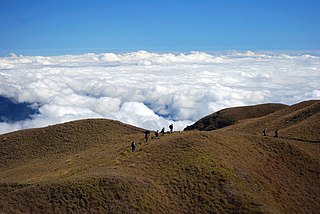
Baguio, officially the City of Baguio, is a 1st class highly urbanized city in the Cordillera Administrative Region, Philippines. It is known as the "Summer Capital of the Philippines", owing to its cool climate since the city is located approximately 4,810 feet above mean sea level, often cited as 1,540 meters in the Luzon tropical pine forests ecoregion, which also makes it conducive for the growth of mossy plants, orchids and pine trees, to which it attributes its other moniker as the "City of Pines".

Benguet, officially the Province of Benguet, is a landlocked province of the Philippines located in the southern tip of the Cordillera Administrative Region in the island of Luzon. Its capital is La Trinidad.

La Trinidad, officially the Municipality of La Trinidad, is a 1st class municipality and capital of the province of Benguet, Philippines. According to the 2020 census, it has a population of 137,404 people.

Atok, officially the Municipality of Atok,, is a 4th class municipality in the province of Benguet, Philippines. According to the 2020 census, it has a population of 19,218 people.

Itogon, officially the Municipality of Itogon,, is a 1st class municipality in the province of Benguet, Philippines. According to the 2020 census, it has a population of 61,498 people.

Sablan, officially the Municipality of Sablan, is a 5th class municipality in the province of Benguet, Philippines. According to the 2020 census, it has a population of 11,588 people.

Tuba, officially the Municipality of Tuba,, is a 1st class municipality in the province of Benguet, Philippines. According to the 2020 census, it has a population of 48,312 people.

Session Road is a six-lane 1.7-kilometer (1.1 mi) major road in Baguio, Philippines. The entire road forms part of National Route 231 (N231) of the Philippine highway network.

Kennon Road, also known as the Rosario–Baguio Road, is a two lane 33.53-kilometer (20.83 mi) roadway in Benguet province in the Philippines connecting the mountain city of Baguio in Benguet to the lowland town of Rosario in La Union province. The project began in 1903 and opened for travel on January 29, 1905. Originally called Benguet Road, it was later renamed in honor of its builder, Col. Lyman Walter Vere Kennon of the U.S. Army Corps of Engineers. It is the second oldest road that leads to Baguio, after Quirino Highway, and the shortest route to Baguio for travelers from Manila and provinces in central and southern Luzon.
The legislative districts of Benguet are the representations of the province of Benguet in the various national legislatures of the Philippines. The province is currently represented in the lower house of the Congress of the Philippines through its lone congressional district.

The MacArthur Highway, officially the Manila North Road, is a 684.855-kilometer (425.549 mi), two-to-six lane, national primary highway and tertiary highway in Luzon, Philippines, connecting Caloocan in Metro Manila to Aparri in Cagayan at the north. It is the second longest road in the Philippines, after Pan-Philippine Highway. It is primarily known as MacArthur Highway in segments from Caloocan to Urdaneta, Pangasinan, although it is also applied up to Ilocos Sur, and likewise called as Manila North Road for the entire length.

Metro Baguio, also known as BLISTT, is an agglomeration of the city of Baguio and five municipalities of the Philippine province of Benguet, namely: La Trinidad, Itogon, Sablan, Tuba, and Tublay.

The Halsema Highway is a national secondary highway in the Philippines. Situated within the Cordillera Central range in northern Luzon, it stretches from the city limit of Baguio to the municipality of Bontoc. Its highest point is at 7,400 feet (2,300 m) above sea level in the municipality of Atok. It was officially recognized as the highest altitude highway in the Philippines until 2019, when the 2.429-kilometer (7,970 ft) high point Kiangan–Tinoc–Buguias Road in Tinoc, Ifugao, was recognized as the new holder of the distinction.

The Aspiras–Palispis Highway is a Philippine major highway in northern Luzon that runs from the city of Baguio in the province of Benguet to the municipality of Agoo in the province of La Union.

The Naguilian Road, officially the Quirino Highway and also known as the Baguio–Bauang Road, is a Philippine major highway in northern Luzon that runs from the city of Baguio in the province of Benguet to the municipality of Bauang in the province of La Union.
The Loakan Road is a 6.2-kilometer (3.9 mi), major road in Baguio, Philippines. It provides access to Loakan Airport located in the outskirts of the city. The entire road forms part of National Route 231 (N231) of the Philippine highway network.

The Asin–Nangalisan–San Pascual Road is a major road in La Union and Benguet, Philippines, serving as an alternative route to Baguio. This road is dangerous, and has tunnels along the way which used to be intended for rail services from Aringay to Baguio. The road officially opened to public on December 17, 2018.
The Benguet–Nueva Vizcaya Road,, is the road system that connects the provinces of Benguet and Nueva Vizcaya in the Philippines.

The Valenzuela Gateway Complex, also known as the Valenzuela Gateway Complex Terminal and Valenzuela Gateway Complex (VGC) Central Integrated Terminal is an inter-regional intermodal transit hub in Valenzuela, Metro Manila, the Philippines. It is planned to be one of three provincial bus stations serving Metro Manila and the principal terminal for province-bound and incoming buses from Central and Northern Luzon regions.
Bado Dangwa was a Filipino entrepreneur, soldier and politician who founded the Dangwa Transportation Company, one of the biggest transport firms in the northern Philippines, and served as Governor of Benguet.


















